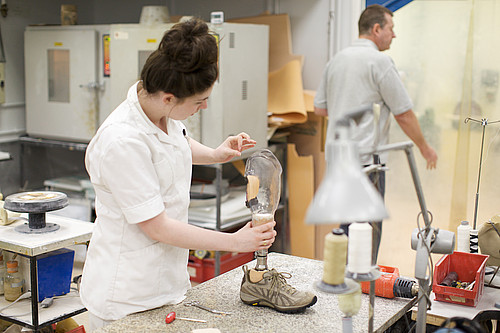I certainly think so. There are over 80,000 allied health professionals (AHPs) working across the NHS, local government, education, private and voluntary sector organisations in England. This is equivalent to at least a million contacts with the public each week. That is a significant number of opportunities to make an impact on public health, which is why Public Health England (PHE) has established my post as lead allied health professional to harness this untapped resource. Many people think our NHS, public health and social care system is unsustainable without radical transformation. The ageing population, increase in lifestyle-related poor health and financial forecasts mean it has never been more urgent to shift our focus to prevention. We need to take every opportunity to create the environment, information and support to help people and communities change their behaviour and to enjoy better health and wellbeing. The allied health professions can contribute in a big way to this system-wide transformation. The 12 professions regulated by the Health Care Professions Council include:
- speech and language therapists
- radiographers
- prosthetists and orthotists
- podiatrists
- physiotherapists
- paramedics
- orthoptists
- occupational therapists
- dietitians
- music therapists
- art therapists
- drama therapists

Unless you've worked with or been treated by an AHP you may not know exactly what they all do, so here is a description of each profession. The breadth of expertise within each profession means AHPs can add value to virtually every public health priority – and many already are. For example:
- Stoke Speaks Out, run by speech and language therapists, is tackling the high incidence of language delay identified in young children across Stoke-on-Trent through a preventive, multi-agency approach. In 2002 local studies identified that 64 per cent of children were entering nursery with significantly delayed language skills. By 2010 this had improved to 39 per cent of children. Speech and language delay has a direct impact on children’s development and educational outcomes, health and well-being.
- With their focus on food, dietitians are on the frontline of the fight against the nation’s obesity epidemic. They lead multi-agency strategies to tackle adult and childhood obesity, inform national guidance and policies, support clear evidence-based information for the public, and work on a range of local programmes to change behaviour and cut obesity. The British Dietetic Association is behind a campaign to encourage retailers to stop putting junk food at the till, where it leads to impulse purchases and pester power from children. As a result, some supermarkets have stopped all sales of junk food at checkouts.
- Radiographers lead the delivery of the NHS Breast Screening Programme which calls women between 50 and 70 years old for a mammogram every 3 years to pick up early signs of breast cancer. Radiographers perform the screening and also use the opportunity to teach women how to recognise the early signs and symptoms of breast cancer.
- Community-based falls prevention programmes tackle one of the biggest health issues facing older people, and reduce costs through hospital admissions. Physiotherapy-led falls prevention services have contributed to reductions in admissions due to falls in the home of 32 per cent, falls in residential institutions of 27 per cent and falls in the street of nearly 40 per cent.
- Occupational therapy is both cost effective and beneficial for older adults with dementia. It improves clients’ mood, quality of life, health status and sense of control over their lives.
Most of the AHPs are using ‘making every contact count’ to have tailored conversations about improving health and wellbeing and supporting clients to make lifestyle behaviour changes. For example, podiatrists use the conversation time they have whilst treating a client to talk about issues such as stopping smoking, losing weight or being more active.

So what needs to happen to make the most of AHPs’ potential to boost our public health efforts? The professionals need to act but they also need support from commissioners and academics. The sort of action needed include: From allied health professionals If you are already doing public health work, talk about it, evaluate it and think how you could do more. If you aren’t doing this work, consider how you could build a public health element into your current role From service planners and commissioners Are you getting public health value from your contracts, have you discussed with your providers how they could support the wider prevention agenda? Public health commissioners could consider whether AHPs should be part of commissioning plans From academics Educators need to ask if their curriculum includes proper attention to public health and prepares the future workforce for a wider role. Researchers need to ask if they can publish more on the potential impact of AHPs on public health. Leadership across all these sectors is needed if we are to drive the expected change. We know what needs to happen and we know how to do it, so we need to work together to realise the potential of AHPs to help improve the health of people in England. PHE is hosting a public health leadership workshop later this week to agree with leaders from professional bodies, academia, NHS England, Health Education England and Department of Health how we will achieve this ambition together. I’ll keep you posted. Featured image courtesy of NHS Photo Library. Used under Crown Copyright

6 comments
Comment by Nick Pahl posted on
A useful post.
Acupuncturists carry out over 4.5 million treatments and research has shown they can improve health and wellbeing and support clients to make better lifestyle and better health choices. I would like to see Acupuncturists, who meet WHO standards of training, being seen as an AHP - British Acupuncture Council members meet these standards.
I hope we can be involved in this conversation and action going forward.
Comment by Rachel Picton posted on
Definitely need to release the potential of AHPs - well said.
Comment by Bren posted on
Hello Linda,
A very interesting and informative blog.
I thought it reflected the wide ranging nature of Allied Hleath Professionals (AHP) and their interconnected areas of work with AHP, Public Health England, and beyond..
I saw in the blog the reference to working with the clients around every contact counts, and I was just wondering if it needed to be seen beyond this? I am just thinking of the work AHPs do when working with clients to plan, deliver and develop the services. This takes us away from the illness and moves to better services with co produced aims and outcomes.
A really great blog and thank you Linda,
Best wishes,
Bren.
Comment by Linda Hindle posted on
Thanks Bren, I totally agree with you about the impact of AHPs at every part of the pathway including their role in planning and developing services. This afternoon I am joining with the acting Chief Health Professions Officer and other AHP colleagues as part of planning around rehabilitation services to see how public health and prevention can be integral to all aspects of rehabilitation.
Comment by David Trotter posted on
Finding ways to aid fall prevention is a very important necessity in our hospitals and care homes. With a fall greatly impacting on the quality of life in seniors throughout the UK, it is in the best interests of both themselves and our health care professionals to find ways to lower the number of people experiencing falls
Comment by bill posted on
very useful , good inf9ormatiion